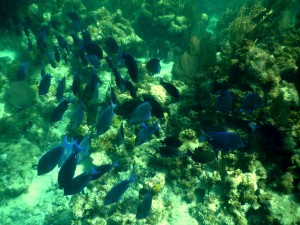
Wake Forest ecology student learn first hand the perils of plastic on Long Caye. Photo by Justin Catanoso
During the week of March 7, 2015 — Spring Break — my wife and I traveled with a group of Wake Forest University students and faculty in a coral ecology class. Arriving in Belize City late morning, we all boarded a boat called the Great White and piloted 47 miles into the Caribbean to Lighthouse Reef Atoll, a remote and mostly untouched set of six islands on the world’s second-largest coral reef. We set up home for the week on Long Caye (2.5 miles long; 0.9 milewide) and the Itza Lodge, a fabulous, rustic eco-lodge used mostly by university groups and some intrepid tourists.
My goal journalistically was to return with a story tied to the underwater marvels we saw while snorkeling daily in the clear turquoise water in the Atoll — including the famous Great Blue Hole. Instead, I came back with a heartbreaking story about our voluminous, reckless use-and-disposal of all manners of plastics, and how it is marring a place as beautiful, pristine and remote as Long Caye.
Aside from public radio report WFDD, my commentary appeared first in Triad Business Journal and soon after on National Geographic online and BusinessInsider.

